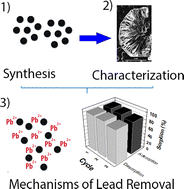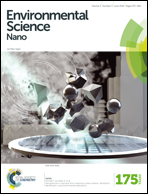Incorporation of graphene oxide into a chitosan–poly(acrylic acid) porous polymer nanocomposite for enhanced lead adsorption†
Abstract
The present study describes the successful incorporation of graphene oxide (GO) into a binary polymer composite blend of chitosan–poly(acrylic acid) (CS–PAA) to obtain porous hydrogel nanocomposite beads with higher lead removal and regeneration capability than any other chitosan hydrogel material or activated carbon. In the present study, we determine the effects of different concentrations of GO in the nanocomposite, as well as the role of pH and nanocomposite load in Pb2+ removal. The mechanisms of sorption and diffusion of lead in this new nanocomposite, as well as its reusability after regeneration were also investigated. The results show that the addition of GO into the polymer blend has increased significantly the metal uptake capacity owing to the additional oxygen-containing functional groups present in GO and the increase in surface area. Additionally, the solution pH affected the nanocomposite adsorption, with the best adsorption occurring at pH 5. The most economical adsorbent loading was determined to be 37.5 g of hydrogel beads per liter of solution. The pseudo second-order model best described the adsorption kinetics and determined that chemisorption was the mechanism of lead removal. The diffusion mechanism of this new nanocomposite was determined using the intraparticle diffusion model, which suggested that adsorption occurred in three distinct phases. The adsorption isotherms for the hydrogel beads all showed excellent fit to the Langmuir isotherm model. The CS–PAA beads with 5% GO presented the highest Pb2+ adsorption capacity (138.89 mg g−1). When this material was subjected to 3 cycles of adsorption–desorption, relatively high removal values were obtained, indicating good reusability and showing that the GO–CS–PAA nanocomposite beads could be applied to remove lead from water.


 Please wait while we load your content...
Please wait while we load your content...